Kereta kebal semasa Perang Dingin

Semasa Perang Dingin (1945-1990), dua kuasa bertentangan di Eropah iaitu negara Pakatan Warsaw di sebelah, dan Pertubuhan Perjanjian Atlantik Utara (NATO) dipihak yang lain. Pakatan Warsaw dilihat oleh Barat sebagai mempunyai pasukan agresif yang mengatasi kuasa-kuasa NATO.
Penguasaan Soviet ke atas Pakatan Warsaw membawa kepada piawaian yang berkesan bagi beberapa reka bentuk kereta kebal. Sebagai perbandingan, NATO mengambil sikap bertahan. Negara-negara yang banyak menyumbang, Perancis, Jerman, Amerika Syarikat, dan United Kingdom membangunkan reka bentuk kereta kebal mereka sendiri, dengan sedikit persamaan, manakala negara-negara kecil NATO membeli atau menyesuaikan reka bentuk ini.
Selepas Perang Dunia II, pembangunan kereta kebal terus berkembang sebahagian besarnya kerana kerana Perang Dingin. Kereta kebal bukan sahaja akan terus dihasilkan dalam jumlah yang besar, tetapi kemajuan teknologi turut berkembang secara mendadak juga. Kereta kebal menjadi lebih besar dan perisainya menjadi lebih tebal dan lebih berkesan. Aspek teknologi senjata berubah juga, dengan kemajuan besar dalam reka bentuk kerangka dan keberkesanan terminal. Walau bagaimanapun, pada masa kini kebanyakan kereta kebal dalam perkhidmatan masih mempunyai senjata api secara manual dimuatkan dari pangkal, sifat dari kereta kebal yang paling awal yang dikongsi dengan kebanyakan senjata api gerak sendiri dan meriam lapangan.

Banyak perubahan pada reka bentuk kereta kebal merupakan peningkatan penyasasaran dan julat (sistem kawalan tembakan), penstabilan meriam, sistem komunikasi dan keselesaan krew. Perisai telah berkembang seiring dengan peningkatan senjata dan meriam telah berkembang menjadi lebih besar. Tetapi tidak ada sebarang perubahan asas.
Reka bentuk dan belanjawan kereta kebal telah diketahui naik dan turun. Selepas perang, belanjawan reka bentuk kereta kebal telah dipotong dan kakitangan kejuruteraan sering bertaburan. Kebanyakan perancang perperangan mempercayai bahawa kereta kebal adalah lapuk, setelah senjata nuklear sudah ada dan ia dirasai bahawa senjata nuklear taktikal boleh memusnahkan mana-mana Briged atau rejimen, sama ada ia adalah berperisai atau tidak. Perang Korea membuktikan bahawa kereta kebal masih berguna di medan perang, memandangkan keraguan kuasa-kuasa besar untuk menggunakan senjata nuklear. Dalam tahun 1950-an, kereta kebal kebanyakan negara 'telah dilengkapi dengan perlindungan NBC, yang membolehkan unit jentera untuk bertahan terhadap senjata nuklear, biologi dan kimia, atau untuk menjalankan penembusan dengan mengeksploitasi medan perang serangan nuklear.
Pembangunan kereta kebal pertempuran utama[sunting | sunting sumber]

Kereta kebal sederhana secara beransur-ansur berkembang membentuk konsep yang baru bagi kereta kebal pertempuran utama. Peralihan ini berlaku secara beransur-ansur pada tahun 1950, kerana ia telah disedari bahawa kereta kebal sederhana boleh membawa senjata api (seperti 90 mm Amerika Syarikat, 100 mm Soviet, dan terutamanya 105 mm British) yang mampu menembusi apa-apa perisai tahap praktikal pada jarak jauh. Konsep Perang Dunia II kereta kebal berat, bersenjata dengan senjata yang paling berkuasa dan perisai paling berat, menjadi usang kerana ia turut sama terdedah seperti kenderaan lain dengan kereta kebal sederhana baru. Begitu juga, Perang Dunia II telah menunjukkan bahawa kereta kebal perisai ringan dengan senjata ringan adalah kurang bernilai bagi kebanyakan peranan. Malah kenderaan peninjau menunjukkan trend ke arah berat badan yang lebih berat dan senjata api yang lebih besar semasa Perang Dunia II; kelajuan bukanlah pengganti perisai dan senjata api.
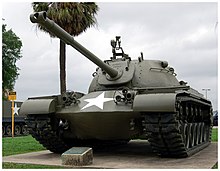
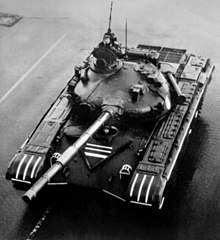
Pelbagai peningkatan senjata anti-kereta kebal dan ancaman yang dilihat akibat satu perang nuklear meningkatkan keperluan bagi perisai tambahan. Perisai tambahan mendorong reka bentuk meriam yang lebih berkuasa.[1] Kereta kebal peperangan utama dengan itu mengambil peranan apa yang pernah dikenali sebagai 'tangki Universal' British, mengisi hampir semua peranan di medan perang. Kereta kebal pertempuran utama biasa sama bersenjata seperti mana-mana kenderaan lain di medan perang, sangat mudah alih, dan juga berperisai dengan baik. Namun ia cukup murah untuk dibina dalam jumlah yang besar. Kereta kebal klasik pertempuran utama tahun 1950 ialah Centurion British, Siri T-55 Soviet, dan siri M47 dan M48 Amerika Syarikat. Ketiga-tiga kenderaan asas telah dinaik taraf dengan ketara dari masa ke masa. Sebagai contoh, Centurion memulakan hayatnya dengan meriam Ordnance QF 17-pounder yang amat berkesan (76.2 mm), tetapi persenjataannya telah dinaik taraf kepada 20 pounder (84 mm) dan kemudiannya pada 105 mm meriam utama menjelang 1959, dengan kawalan api yang lebih baik dan enjin baru.
Kereta kebal T-55 Russia bermula dengan meriam 100 mm, tetapi telah dipertingkatkan dengan kedua meriam 115 mm dan 125 mm, sistem kawalan tembak dipertingkat, enjin baru, trek dll. Siri M47 berubah menjadi siri M60.Kereta kebal utama Soviet yang pertama adalah T-64[2] while the first American MBT was the M48 Patton.[3]
Kenderaan ini dan hasilannya membentuk sebahagian besar dari pasukan perisai bagi NATO dan Pakatan Warsaw sepanjang Perang Dingin. Sesetengah dari mereka kekal digunakan sehingga kurun ke-21.
Kereta kebal ringan[sunting | sunting sumber]

Kereta kebal ringan terus dihasilkan tetapi bagi tujuan peranan terhad seperti penninjau afimbia, menyokong unit bawaan udara, dan dalam pasukan gerak pantas yang ditak dijangkakan akan bertembung dengan kereta kebal musuh. PT-76 Soviet merupakan contoh yang baik bagi kereta kebal khusus. Ia memiliki keupayaan afimbia dan memiliki kuasa tembakan bagi membinasakan kenderaan peninjau yang lain, tetapi ia juga berperisai ringan. M551 Sheridan Amerika SYarikat memiliki kekuatan dan kelemahan yang sama, tetapi juga boleh dijatuhkan dari udara, samaada melalui payung terjun atau LAPES.
Tolong bantu menterjemahkan sebahagian rencana ini. Rencana ini memerlukan kemaskini dalam Bahasa Melayu piawai Dewan Bahasa dan Pustaka. Sila membantu, bahan-bahan boleh didapati di Kereta kebal semasa Perang Dingin (Inggeris). Jika anda ingin menilai rencana ini, anda mungkin mahu menyemak di terjemahan Google. Walau bagaimanapun, jangan menambah terjemahan automatik kepada rencana, kerana ini biasanya mempunyai kualiti yang sangat teruk. Sumber-sumber bantuan: Pusat Rujukan Persuratan Melayu. |
Kereta kebal berat[sunting | sunting sumber]

Kereta kebal berat seperti T-10 terus dibangunkan dan digunakan bersama kereta kebal serdahana sehingga 1960-an dan 1970-an, sehingga pembangunan peluru berpandu anti-kereta kebal dan meriam kereta kebal berkuasa menjadikan ia tidak berkesan di medan pertempuran dalam peranan yang dimainkan oleh mereka.
Gabungan kepala peledak HEAT yang besar, digabung dengan julat berkesan yang jauh berbanding meriam kereta kebal, dan dengan ketepatan tinggi bererti kereta kebal berat tidak lagi dapat berfungsi dalam bertembungan, atau peranan pelindung. Peluru berpandu anti kereta kebal mampu mengisi peranan ini sama baik.
Kereta kebal serdahana juga lemah pada peluru berpandu baru, tetapi dapat digunakan dalam bilangan lebih besar dan memiliki pergerakan medan tempur yang lebih tinggi. Tambahan lagi, nilai kereta kebal ringan bagi meninjau berkurangan dengan banyaknya oleh helikopter, sungguhpun banyak kereta kebal ringan masih digunakan.
Pembangunaan senjata anti kereta kebal dan langkah penangkisan[sunting | sunting sumber]

Terdapat juga perbincangan bahawa kereta kebal adalah lapuk dan belanjawan mengurang sedikit selepas Perang Yom Kippur 1973 apabila kereta kebal Israel dibinasakan dalam bilangan besar yang tidak pernah berlaku menggunakan peluru berpandu berwayar disandang (ATGMs), ditembak oleh tentera pejalan kaki Mesir. Analisa berikutnya menunjukkan bahawa pasukan Israel memandang rendah lawan mereka pada fasa pertama perang; kesemua taktik kereta kebal mereka mengabaikan keupayaan baru tentera pejalan kaki yang dilengkapi dengan senjata AT murah bagi menghentikan kereta kebal. Penyelesaian pada persekitaran medan pertempuran baru ini adalah gabungan taktikal dan teknikal. Secara tektik, terdapat kesedaran baru bagi keperluan taktik gabungan persenjataan. Ini mendorong pada mekanisma pasukan infantri dan kemajuan taktik artileri maju dan kepala peledak. Kereta kebal bersendirian lemah pada infantri, tetapi gabungan pasukan kereta kebal, infantri mekanikal, dan artileri mekanikal masih mampu menang di persekitaran baru ini.
Pada tahun 1974, Amerika Syarikat memulakan program mengagumkan bagi memodenkan armada kereta kebal sedia adanya dan memulakan penghasilan pukal M60A1, dan kemudiannya M60A3; pada masa yang sama ketika M1 dibangunkan. Belanjawan bagi reka bentuk dan penghasilan kereta kebal meningkat semasa pentadbiran Ronald Reagan, berikutan ketegangan antara Amerika Syarikat dan Soviet Union.
Sebagai tindak balas pada ATGMS mudah-alih Infantri dan muatan kenderaan, perisai kenderaan lebih berkeupayaan telah dibangunkan. Perisai ruang, perisai komposit, perisai letupan reaktif, dan sistem perlindungan aktif—seperti sistem Russia Shtora, Drozd, dan Arena—dipasang pada kereta kebal baru dan lama. Di sebalik peningkatan ini peluru berpandu besar kekal sangat berkesan menentang kereta kebal. Ini dibuktikan pada tahun 1991 apabila kejadian tembakan sahabat, peluru berpandu anti-kereta kebal Hellfire membinasakan sebuah kereta kebal M1 Abrams terbaru.
Missile armed tanks[sunting | sunting sumber]


During the latter half of the 20th century, some tanks were armed with ATGMs (Anti-Tank Guided Missiles) which could be launched through a smoothbore or (in the case of "Shillelagh") a rifled main gun barrel with a provision to prevent imparting "spin" to the missile. In the U.S., the M60A2, M551 Sheridan, and prototype MBT-70, with 152 mm barrel/launchers used the Shillelagh infrared-guided missile.
The MBT-70 was cancelled prior to production due to high cost, and superseded by the M1 Abrams, which used a conventional gun. The M551 and the M60A2 were widely considered disappointing due to problems of overall complexity, sensitive advanced electrical systems (some components of which involved the Shillelagh guidance system) and issues related to the conventional rounds with combustible cases, though the Sheridan would serve into the 1990s before finally being withdrawn. The M60A2's were eventually replaced by M60A3s using conventional 105 mm guns.
While U.S. experiments with gun-launched missiles led to a dead end, the Soviet Union put this technology into service in the mid-1970s, and it continues to be used in CIS forces. Tanks capable of firing gun-launched missiles in Russian service include the T-72, T-90, and upgraded T-55 (T-55AM2). Ukraine also employs missile-armed T-64, T-80, and T-84 tanks.
History in the Cold War[sunting | sunting sumber]
Korean War[sunting | sunting sumber]
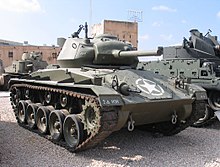
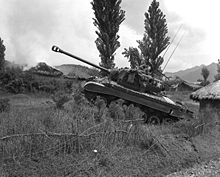

In the Korean War M24 Chaffee's were the first U.S. tanks to fight the North Korean T-34-85s. The M24 fared poorly against these much better-armed and armored medium tanks which were superior to the M-24. M24s were more successful later in the war in their reconnaissance role, supported by heavier tanks such as the kereta kebal M4 Sherman, M26, and M46.
The heavier but older M26 Pershing was deemed unsatisfactory due to its inferior mobility, which was unsuitable for a medium tank role as it used the same engine that powered the much lighter M4 Sherman, and in November, 1949, the upgraded M26 received a new power plant and a main gun with bore evacuator, and the M46 Patton designation. Less than a thousand were upgraded to M46 standard.
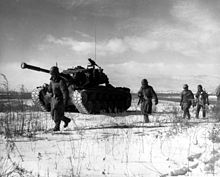
On 8 August 1950 the first M46 Pattons landed in South Korea. The tank proved superior to the much lighter North Korean T-34-85, which were encountered in relatively small numbers. By the end of 1950, 200 M46 Pattons had been fielded, forming about 15% of US tank strength in Korea; the balance of 1,326 tanks shipped to Korea during 1950 included 679 M4A3 Shermans, 309 M26 Pershings, and 138 M24 Chaffee light tanks.[4] Subsequent shipments of M46 and M46A1 Pattons allowed all remaining M26 Pershings to be withdrawn during 1951, and most Sherman equipped units were also reequipped.[5]
By 1953 the M24 Chaffee's were completely replaced by the new M41 tank in the United States Army which was rushed to the battlefield. It was later designated the M41 Walker Bulldog. The M41 was an agile and well armed. On the other hand, it was noisy, fuel-hungry and heavy enough to cause problems with air transport. The Walker Bulldog saw limited combat with the U.S. Army during the Korean War, but the conflict served as a testing ground to work out the tank's deficiencies, especially with its rangefinder.

British tanks, the Centurion tank with Cromwell tanks for reconnaissance, arrived in Korea in late 1950. The tanks had to operate in much colder conditions than their usual North German Plain deployments. The Centurions covered the retreat at the battle of the Imjin River with the tanks from C Squadron, 8th Hussars, under the command of Major Henry Huth and by 55 Squadron, Royal Engineers. The British position on the Imjin river "was deemed safe" but vulnerable in case of an attack which prove to be case,[6] and the tanks were able stand their ground in the battle. The Centurions were also in Operation Commando and were used to capture high ground earning praise from the commander of I Corps. Thereafter the war was largely static and the Centurions were used as artillery against the infantry attacks which generally happened at night.[7]
Interwar[sunting | sunting sumber]
The M47 Patton was intended to replace the M46 Patton and M4 Sherman tanks. It had a 90 mm gun and a crew of 5. Despite it being the primary tank of the US it never saw combat while in US service. In Early 1951, the U.S. initiated the design of the M48 Patton, designated the T-48 with a 90 mm cannon.[8] The T48 featured a new turret, new redesigned hull and an improved suspension. The hull machine gunner position was removed, reducing the crew to 4. On 2 April 1953, the Ordnance Technical Committee Minutes (OTCM), standardized the last of the Patton series tanks as the M48 Patton.
Nearly 12,000 M48s were built from 1952 to 1959. The early designs, up to the M48A2, were powered by a gasoline 12-cylinder engine which was coupled with an auxiliary 8-cylinder engine. The gas engines gave the tank a short operating range and were prone to catching fire when hit. This version was considered unreliable.

The M103 heavy tank was manufactured at the Detroit Arsenal Tank Plant and the first units were accepted in 1957.
The M103 was designed to counter Soviet heavies. Its long-ranged 120 mm cannon was designed to hit enemy tanks at extreme distances, but it was never used in combat. Of the 300 M103s built, most went to the Marines.[9] The tank was relatively underpowered and the drive systems were fragile.The turret of the M103 was larger than that of the M48 or the M60 to make room for the huge 120 mm gun and the two loaders assigned to it, in addition to the gunner and the commander. The driver sat in the hull. The gun was capable of elevation from +15 to -8 degrees.
The British introduced their Heavy Gun Tank F214 Conqueror with the same 120mm gun as the M103 into service in 1955. It stayed in service until 1960; the upgrading of Centurion tank to the L7 105mm gun having removed its purpose.
While the US Army deactivated its heavy armor units with the reception of the new M60 series main battle tanks in 1960, the remaining M103s stayed within the US Marine Corps inventory until they began receiving the M60 series MBT. With the disappearance of the heavy tank from US forces came the full acceptance of the main battle tank in 1960 for the US Army, and later for the US Marine Corps.[10]
The British successor to Centurion was Chieftain in 1966. Chieftain was heavily armoured and had a 120mm gun following a doctrine of long range fire and survivability that would be needed against the more numerous Warsaw Pact tanks in the event of an invasion of West Germany.
Vietnam War era[sunting | sunting sumber]

Tanks for the most part, saw limited action in Vietnam compare to the heavy fighting in Korea, but even in the Vietnam jungle the M48 Patton saw tank-to-tank duels. On March 3, 1969, the Special Forces camp at Ben Het was attacked by the NVA 202nd Armored Regiment. The 202nd was tasked with the mission of destroying the camp's 175 mm self-propelled guns.[12][13] One of the PT-76s had detonated a land mine, which not only alerted the camp, but also lit up the other PT-76s attacking the firebase. Flares had been sent up, thus exposing adversary tanks, but sighting in on muzzle flashes, one PT-76 scored a direct hit on the turret of a M48, killing two Patton crewmen and wounding two more. A second Patton, using the same technique, destroyed a PT-76 with their second shot. At daybreak, the battlefield revealed the wreckage of two PT-76s and one BTR-50 armored personnel carrier.[12]

The M48s saw extensive action during the Vietnam War, over 600 Pattons would be deployed with US Forces during the war.[14] The initial M48s landed with the US Marines in 1965.[12] Remaining Pattons deployed to South Vietnam were in three U.S. Army battalions, the 1-77th Armor near the DMZ, the 1-69th Armor in the Central Highlands, and the 2-34th Armor near the Mekong Delta. Each battalion consisted of approximately fifty seven tanks. M48s were also used by Armored Cavalry Squadrons in Vietnam, until replaced by M551 Sheridan tanks. The M67A1 flamethrower tank (nicknamed the Zippo) was an M48 variant used in Vietnam.
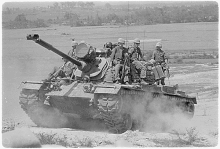
When US forces commenced redeployment operations, many of the M48A3 Pattons were turned over to the Army of the Republic of Vietnam (ARVN) forces, in particular creating the ARVN 20th Tank Regiment; which supplemented their M41 Walker Bulldog units. During the North Vietnamese Army (NVA) Easter Offensive in 1972, tank clashes between NVA T-54/PT-76 and ARVN M48/M41 units became commonplace, but on 23 April 1972, tankers of the 20th Tank Regiment were attacked by an NVA infantry-tank team, which was equipped with the new 9M14M Malyutka (NATO designation: Sagger) wire guided anti-tank missile. During this battle, one M48A3 Patton tank and one M113 Armored Cavalry Assault Vehicle (ACAV) were destroyed, becoming the first losses to the Sagger missile; losses that would echo on an even larger scale a year later during the Yom Kippur War in the Middle East in 1973.[12]
In the mid-1970s, the M48A5 upgrade was developed to allow the vehicle to carry the heavier 105 mm gun. This was designed to bring the M48s up to speed with the M60 tanks then in regular use. Most of the M48s were placed into service with reserve units by this time. By the mid-1990s, the M48s were phased out.
The M48s performed admirably[15] in Vietnam in the infantry-support role. However, there were few actual tank versus tank battles. The M48s provided adequate protection for its crew from small arms, mines, and rocket-propelled grenades.

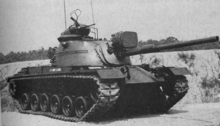
The plans were laid in the US in the late fifties, for a tank with a 105 mm main gun and a redesigned hull offering better armor protection. The resulting M60 largely resembled the M48 it was based on, but has significant differences. The M60 mounted a bore evacuated 105 mm main gun, had a hull with a straight front slope whereas the M48's hull was rounded, had three support rollers per side to the M48's five, and had road wheels constructed from aluminum rather than steel.
The hull of the M60 was a single piece steel casting divided into three compartments, with the driver in front, fighting compartment in the middle and engine at the rear.[16] The driver looked through three M27 day periscopes, one of which could be replaced by a night vision periscope.[16] Initially, the M60 had essentially the same turret shape as the M48, but this was subsequently replaced with a distinctive "needlenose" design that minimized frontal cross-section to enemy fire. The M60 was the last US main battle tank to utilize homogeneous steel armor for protection. It was also the last to feature either the M60 machine gun or an escape hatch under the hull.
Originally designated the M68, the new vehicle was put into production in 1959, reclassified as the M60, and entered service in 1960. Over 15,000 M60s (all variants) were constructed.
In 1963, the M60 was upgraded to the M60A1. This new variant, which stayed in production until 1980, featured a larger, better-shaped turret and improvements to the armor protection and shock absorbers. The M60A1 was also equipped with a stabilization system for the main gun. However, the M60A1 was still not able to fire on the move, as the system only kept the gun pointed in the same general direction while the tank was traveling cross country. It did however enable the coaxial machine gun to be brought to bear while moving.

The M551 Sheridan was initiated when the replacement for the M41 Walker Bulldog, the T92 Light Tank, was canceled.
The need for even lighter weight to make the tank transportable presented the design with a particularly difficult problem; guns capable of defeating modern tanks at reasonable ranges were so large that they demanded a large vehicle to carry them, so large that they couldn't be used as a "light" tank. The use of HEAT rounds instead of conventional penetrating ammunition could address this, but HEAT rounds work better at larger calibers. Gun weight is typically the product of caliber and muzzle velocity, so in the case of the XM551 they sacrificed the muzzle velocity, producing the low-velocity but relatively large-caliber 152 mm M81. HEAT rounds fired by the M81 could defeat any contemporary tank at shorter ranges, but its low velocity made it difficult to use at longer ranges, especially against moving targets. The large low-velocity gun was also ideal for infantry support, where higher performance anti-tank guns would often fire right through soft targets and their small-caliber guns left little room for explosive filler. The M551 Sheridan tank would thus be ideal for both direct fire support as well as short-distance anti-tank engagements.
The only niche where the M551 Sheridan was not ideal was the medium and long-range anti-tank engagement. The muzzle velocity was so low that a HEAT round fired at longer ranges would have to be "lofted", making aiming difficult, and the flight time would be so long that a moving target would be very difficult to hit. However, it appeared there was a solution to this problem by equipping the tank with gun-fired anti-tank missiles. For longer range engagements a missile would be fired instead of a HEAT round, and although its velocity would also be relatively slow, the guidance system would make a hit highly likely anyway. The M551 Sheridan appeared to offer the best of both worlds; for infantry support the large calibre gun allowed it to fire full-sized artillery rounds and canister shot, while also giving it reasonable short-range anti-tank performance from the same gun.
The M551 Sheridan had a steel turret and aluminum hull. It was powered by a large diesel engine. The M551 thus had excellent mobility, able to run at speeds up to 45 mph, which at that time was unheard of for a tracked vehicle. Swimming capability was provided by a flotation screen. Production started on late July 1966, and entered service in June 1967. More than 1,600 M551s were built between 1966 and 1970. Total cost of the M551 program was $1.3 billion.
The vehicle proved to be very noisy and unreliable under combat conditions. The armor was thin enough that it could be penetrated even by heavy machine gun rounds as well as being highly vulnerable to mines. Firing the gun would often adversely affect the delicate electronics, which were at the early stages of transitioning to solid state, so the missile and guidance system was omitted from vehicles deployed to Vietnam. The gun had problems with cracks developing near the breech after repeated firing. Most field units were modified to help address the problem but gun also was criticized for having too much recoil for the vehicle weight, the second and even third road wheels coming clear off the ground when the main gun fired.
The Sheridan saw extensive action in the Vietnam War, being assigned to nearly all armored cavalry squadrons in country. In 1969, armored cavalry units began replacing their M48 Patton tanks.
The battle reports from the troops were sometimes glowing, while the reports higher up the chain of command were often negative. A 1969 evaluation of the vehicles found the M551 was employed in reconnaissance, night patrol and road clearing, accumulating 39,455 road miles and 520 combat missions, with a ready rate of 81.3 percent. Despite vulnerability to rockets and mines, it was judged worth applying modifications and equip all cavalry squadrons with the Sheridan.[17]
The Sheridan was much appreciated by the infantry who were desperate for direct-fire support, which generally served in combination with ACAVs (M113s) as armored cavalry units consisted of both M113s and M551s as part of their TO&E. Armor units consisted solely of tanks (minus headquarters company) and Mechanized Infantry units consisted solely of M113s. In this role the real problem with the Sheridan was its limited ammunition load of only 20 rounds and 8 missiles (though M551s in Vietnam service were not equipped with missiles or their guidance equipment, increasing the basic load of conventional rounds).
A common field-modification was to mount a large steel shield, known as an "ACAV set" (Armored Cavalry Assault Vehicle), around the commander's 50-cal. (12.7 mm) gun, allowing it to be fired with some level of protection. The driver has an unusual rotating hatch which has vision blocks when rotated forward. Included with the set was an extra layer of steel belly armor which was bolted onto the vehicle's bottom, although only covering from the front to halfway to the end, possibly due to weight reasons.
A standard modification made during the mid-70's was the addition of the "Cereal Bowl" commander's cupola. This mod came about due to the broken rib effect that occurred when the Sheridan fired conventional rounds, the recoil would pitch the TC against the armor plating resulting in cracked ribs.
Post-Vietnam[sunting | sunting sumber]
The US Army began to phase out the Sheridan in 1978, although at the time there was no real replacement. Nevertheless the 82nd Airborne were able to keep them on until 1996. The Sheridan was the only air-deployable tank in the inventory, and as an elite force they had considerably more "pull" than general infantry and armor units who were forced to get rid of them. Their units were later upgraded to the M551A1 model, including a thermal sighting system for the commander and gunner.

The Sheridan's only air drop in combat occurred during Operation Just Cause in Panama in 1989, when fourteen M551's were deployed; four were transported by C-5 Galaxies and ten were dropped by air, but two Sheridans were destroyed upon landing.[18] The Sheridans' performance received mixed reviews. They were lauded by their operators and some commanders as providing firepower in needed situations to destroy hard targets. However, the Sheridans' employment of only HEAT rounds limited their effectiveness against reinforced concrete construction.
Fifty-one Sheridans were deployed in the Gulf War as some of the first tanks sent. They would not be very effective against the Russian-built T-72s. Their role was limited by age and light armor to reconnaissance duties, possibly 6 or less Shillelagh missiles were fired[19] at Iraqi bunkers, these fewer than a half-dozen missiles, were the only time that the Shillelagh had been fired in a combat environment, from the inventory of the aforementioned 88,000 missiles produced.
Several attempts to upgun or replace the Sheridan have been made, but none were successful. Several experimental versions of the Sheridan mounting a new turret carrying a 105 mm gun were made, but the resulting recoil was too great. Several possible replacements for the M551 were tested as a part of the XM8 Armored Gun System and Expeditionary tank efforts of the early and late 1980s respectively, but none of these entered service. The Stryker Mobile Gun System has replaced the light tank role of the United States.

During the 1960s, the US and West Germany entered a joint project for a new tank common to both armies and intended to enter service in the 1970s. The MBT-70 project was technically advanced with sophisticated suspension, a low silhouette, spaced armor and advanced gun systems but suffered from excessive costs and the Germans pulled out of the project at the end of the decade.
After Vietnam, the M60 Patton was upgraded and designated the M60A2. It featured an entirely new low-profile turret with a commander's machine-gun cupola on top, giving the commander a good view and field of fire while under armor but spoiling the low profile. It also featured a 152 mm cannon, which fired conventional rounds as well as guided missiles.
The M60A2 proved a disappointment, though technical advancements would pave the way for future tanks. The Shillelagh/M60A2 system was phased out from active units by 1981, and the turrets scrapped. Most of the M60A2 tanks were rebuilt as M60A3.[20]
In 1978, work began on the M60A3 variant. It featured a number of technological enhancements, including smoke dischargers, a new rangefinder, and M21 ballistic computer, and a turret stabilization system. In addition it reverted to the 105 mm cannon. All active American M60s eventually underwent the conversion to the A3 model. The M60A3 was phased out of US service in 1997.[21]

The German Leopard tank, another 105mm armed tank, was introduced in 1965. It was sold widely to several nations in NATO as well as worldwide. It was followed in 1979 by the Leopard 2 with a 120mm smoothbore gun.
In 1976, prototypes of a new tank which became the M1 Abrams were delivered by Chrysler Defense and General Motors armed with a 105 mm rifled cannon. The Chrysler Defense design was selected for development as the M1. In 1979, General Dynamics Land Systems Division purchased Chrysler Defense. The M1 Abrams came from the diverted funds from the over budget and impractical MBT-70 and XM815 projects.
The M1 was the first of its kind. It feature a low profile turret and for the first time ever on a tank, composite Chobham armor. Despite all these advances, the Abrams still retained the 4-man crew of the M60 Patton as the autoloader was considered unproven and risky. It was armed with the same L7-derived 105mm gun as the M60. Over 3200 M1 Abrams were produced and first entered US Army service in 1980. About 6,000 upgraded M1A1 Abrams were produced and used the German 120 mm smoothbore cannon, improved armor, and a CBRN protection system.
As the Abrams entered service in the 1980s, they would operate alongside M60A3 Patton. These exercises usually took place in Western Europe, especially West Germany, but also in some other countries like South Korea. During such training, Abrams crews honed their skills for use against the Soviet Union. However, by 1991 the USSR had collapsed and the Abrams would have its trial by fire in the Middle East.
The British FV4030/4 Challenger, continuing with a 120mm rifled gun for long range accuracy and the use of widest type of rounds, and protected by Chobham armor entered service in 1983.
Gulf War/Iraq war[sunting | sunting sumber]

The Gulf War saw the US Marines still deploying obsolete M60 Pattons while the rest of the tank forces had Abrams. The Iraqi forces were initially regular army units, equipped with tanks such as T-54/55 tanks and T-62s. The Coalition main battle tanks, such as the U.S. M1 Abrams, British Challenger 1, and Kuwaiti M-84AB were vastly superior to the Chinese Type 69 and domestically built T-72 tanks used by the Iraqis, with crews better trained and armoured doctrine better developed.

The majority of Iraqi armored forces still used old Chinese Type 59s and Type 69s, Soviet-made T-55s from the 1950s and 1960s, and some poor quality Asad Babil tanks (domestically assembled tank based on Polish T-72 hulls with other parts of mixed origin). These machines were not equipped with up-to-date equipment, such as thermal sights or laser rangefinders, and their effectiveness in modern combat was very limited.
The Iraqis failed to find an effective countermeasure to the thermal sights and sabot rounds used by Coalition armour. This equipment enabled them to engage and destroy Iraqi tanks from more than three times the range that Iraqi tanks could engage coalition tanks. Some Iraqi crews even fired training rounds at the U.S. and British tanks. These rounds (purchased in great number during the Iran-Iraq War due to their inexpensive cost) had soft steel penetrators and thus no hope of penetrating the advanced Chobham Armour of the Coalition tanks.
In the Iraqi war in 2003, an Iraqi division the 6th Armored Division of the Iraqi Army.[22] which was equipped with T-55s and BMP-1s defending the control of key bridges over the Euphrates River and the Saddam Canal at Nasiriyah, were decimated by US Marines with M1 Abrams, and the division as a unit rendered incapable for combat during the Battle of Nasiriyah in March 2003, during the invasion.
In addition to the T-54/55 and T-62 tanks that Iraq had, the most feared to US amoured forces were the T-72 tanks in the Iraqi forces. Only Republican Guard divisions were equipped with Iraqi-modified T-72s. Many of the Iraqi T-72s were dug-in or hidden in groves, and then used to ambush the US or British tanks. In the war, the Iraqi T-72s were the preferred target for Apache helicopters and A-10s, in an attempt to diminish the combat power of Republican Guard divisions. The only chance for the Asad Babil T-72s against American tanks was to lure them to close range combat, or trying to ambush them from dug-in positions.[23]

But even in those conditions, the M1s usually prevailed, as proven in circumstances like the Battle of Baghdad, and the drive to the capital, where dozens of Iraqi MBTs were obliterated,[24] or near Mahmoudiyah, south of Baghdad, April 3, 2003, (Iraqi Freedom) when US tanks engaged their counterparts from just 50 yards, shattering seven enemy T-72s without losses.[25] The Lion of Babylon T-72 was utterly outclassed by the M1 Abrams, the Challenger and by any other contemporary Western main battle tank during the 2003 invasion of Iraq.[26]
See also[sunting | sunting sumber]
- History of the tank
- Tanks in World War I
- Comparison of World War I tanks
- Tanks of the interwar period
- Tanks in World War II
- Comparison of early World War II tanks
- Cold War Tanks
- Post-Cold War Tanks
References[sunting | sunting sumber]
- ^ Front Cover Thomas W. Zarzecki (2002). Arms diffusion: the spread of military innovations in the international system. Psychology Press. m/s. 212. ISBN 0-415-93514-8. Dicapai pada 5 April 2011.
- ^ T-64 manual ("Танк Т-64А. Техническое описание и инструкция по эксплуатации. 1984") menyatakan T-64 sebagai kereta kebal "tempur utama", sementara kereta kebal T-62 dan T-55 sebelumnya (dalam buku panduan tentera setara, seperti "Танк Т-62. Руководство по материальной части и эксплуатации. 1968") dinyatakan sebagai kereta kebal "serdahana"
- ^ MIL-T-45308 state "Tank, Main Battle, 105MM Gun, M60", while MIL-T-45148 state "TANK, COMBAT, FULL-TRACKED, 90MM GUN, M48A2"
- ^ Steven J. Zaloga "M26/M46 Pershing Tank 1943–1953" ISBN 1-84176-202-4 pp.39-40
- ^ Donald W Boose Jr."US Army Forces in the Korean War 1950-53" ISBN 1-84176-621-6 pp.52,75-86
- ^ Hastings 1987, m/s. 253.
- ^ Centurion 1943-2003 p18-20
- ^ Hunnicutt/p. 85 & 152
- ^ Hunnicut/Firepower
- ^ Hunnicutt[halaman diperlukan]
- ^ Starry
- ^ a b c d Dunstan
- ^ Starry, p. 153
- ^ Starry/Hunnicutt
- ^ Nolan
- ^ a b http://www.historyofwar.org/articles/weapons_m60patton.html
- ^ [1] Washer evaluation 1969.
- ^ Doyle, p. 44, 46
- ^ Doyle, p. 4
- ^ Patton Mania M60
- ^ "Development and History of the M-60 tank". Diarkibkan daripada yang asal pada 2010-01-11. Dicapai pada 2015-05-17.
- ^ RJ Lee, Key Components of the Iraqi Ground Forces, 2002[pautan mati kekal]
- ^ Scales, page 269: "As TF 1-37th Armor crossed over the ridge into the heart of the Iraqi defensive zone, the Iraqi commander's carefully disposed rear-slope defense stripped Dyer's tanks of their range advantage. Within 1,000 meters, a row of dug-in T-72s and BMPs suddenly appeared below the crest. All were hull-down in prepared positions behind thick dirt walls (thus disproving the much-quoted u.s. truism that soviet tanks had difficulties in achieving 'hull down' position). Now the Americans were well within Iraqi killing range, and although the Soviet-made night sights were markedly inferior, things could still get very dicey."
- ^ Scales, page 270: "After the war they (TF 1-37th) returned to count the burned-out hulks of 76 T-72s, 84 BMPs, 3 air defense artillery pieces, 8 howitzers, 6 command vehicles, 2 engineer vehicles, and myriad of trucks."
- ^ Conroy & Mars, p. 158
- ^ ТАНКИ ИРАКСКОЙ АРМИИ. otvaga2004.narod.ru (dalam bahasa Russian). December 29, 2009. Diarkibkan daripada yang asal pada 2009-09-05. Dicapai pada 2015-05-17. Unknown parameter
|trans_title=ignored (bantuan)CS1 maint: unrecognized language (link)
